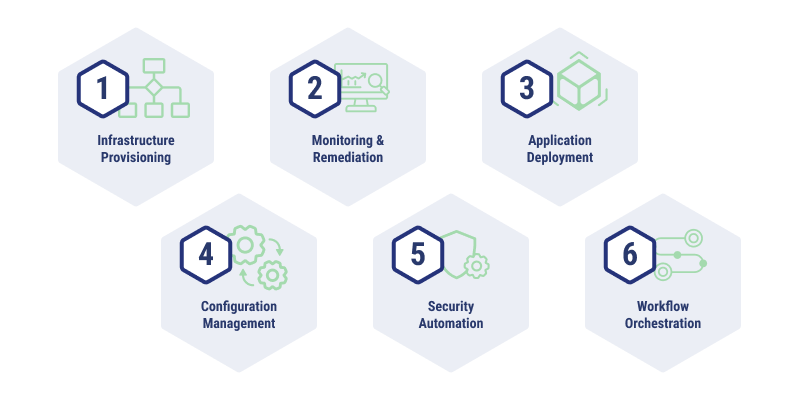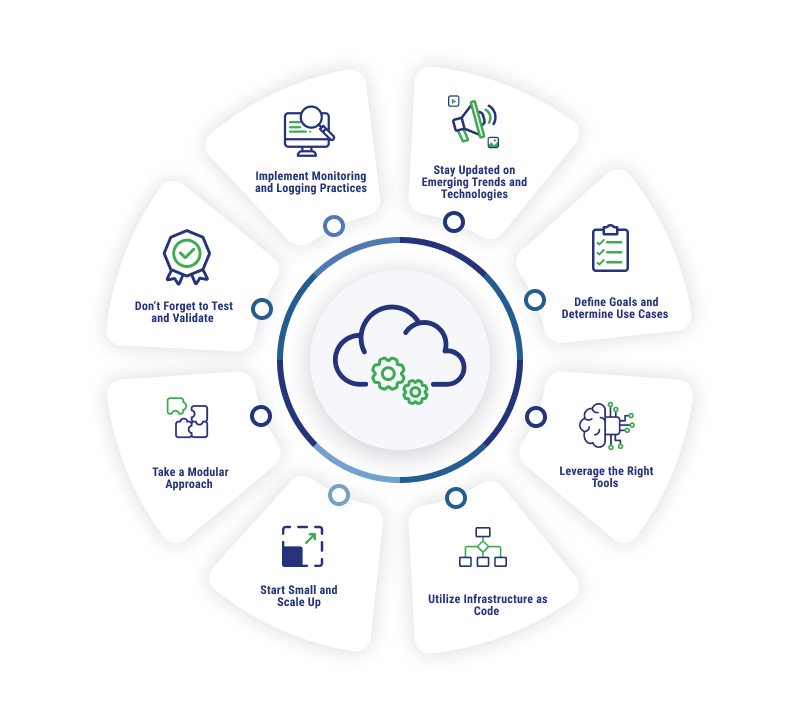
Cloud computing enables companies to run applications, deliver services, and store data with greater ease and efficiency. However, other roadblocks may prevent cloud operations from being as effective as possible. This is where DevOps and cloud automation come in.
DevOps teams rely heavily on cloud automation. This organizational structure brings together software development and operations team members to improve the development and deployment process. However, cloud automation can improve business processes in many other ways outside of this team.
Here’s how you can get the most out of cloud automation and grow with evolving technology.
What is Cloud Automation?
Cloud automation is the practice of using different approaches to reduce human intervention in tasks related to cloud computing environments. It involves implementing tools and processes that automate the provisioning, configuration, management, and optimization of resources and services in the cloud.
At its core, cloud automation enables the automated setup and deployment of virtual machines (VMs), containers, storage, networks, and other infrastructure components on-demand. This is made possible through the use of Infrastructure as Code (IaC), which allows organizations to codify their infrastructure resources into text-based configuration files. These IaC files can then be versioned, tested, and automatically deployed through cloud automation workflows.
After cloud resources are set up, automation can be used to put ongoing tasks on autopilot, such as performance monitoring, software patching, and resource scaling. IaC plays a role here as well, ensuring that the configuration of these cloud resources is maintained consistently across environments according to defined policies and standards which helps minimize manual errors and drift.
How Does Cloud Automation Work?
Cloud automation works by taking every day, manual processes and making them run automatically. Organizations can automate deployments in several different ways, but common approaches involve using artificial intelligence (AI), IaC, or configuration management tools to define the outcome you want from a given trigger or inciting event.
A trigger could be a specific time of day, a desired action, or a code push that incites an action or a series of actions to take place. Businesses may choose to automate provisioning resources, such as storage or servers; application deployment; security settings; or steps in a workflow to welcome new customers. Any tasks with predictable, repeatable steps may be able to be automated.
Types of Cloud Automation
Cloud automation encompasses many tools and practices, so there are a number of different types of cloud automation.

Some of the most common forms of cloud automation include:
- Infrastructure Provisioning: Automating the process of setting up and managing cloud resources, often using IaC to define and manage infrastructure through code. This includes automating the provisioning of serverless architectures.
- Monitoring and Remediation: Automating the monitoring of cloud environments to detect and diagnose issues and leveraging observability tools to provide insights into system behavior, performance metrics, and log data.
- Application Deployment: Automating the deployment of applications to streamline the release process, integrating DevOps tools and practices to automate building and testing.
- Configuration Management: Automating the maintenance of consistent configurations across multiple cloud environments, detecting and remedying configuration drift to ensure systems remain in the desired state.
- Security: Integrating security practices into the DevOps pipeline (DevSecOps), automating the implementation of security controls, vulnerability scanning, and compliance policy enforcement.
- Workflow Orchestration: Automating the sequencing and coordination of complex cloud-related tasks and processes, improving agility, scalability, and reliability in cloud operations.
Advantages of Cloud Automation
Repetitive tasks can add a lot of time to your day without you realizing it. Automation frees team members up from repetition, saving time and allowing them to focus on more interesting activities.
Manual tasks are also more prone to human error, something that cloud automation can greatly reduce. When you automate deployments, you speed up tasks like provisioning and can bring applications and services to market more quickly.
Optimized resources and processes will also save your organization money over time. According to NetApp’s 2023 State of Cloud Ops report, 82% of organizations believe that automation is either “critical” or “very valuable” when it comes to improving return on investment and optimizing operations in the cloud.
Disadvantages of Cloud Automation
Before starting any cloud automation project, it’s important to get leadership on board with the initial investment in time and money. The payoff of cloud automation comes after implementation, but the upfront investment in tools and training has to be factored into an organization’s budget.
Cloud automation offers a lot of freedom and flexibility, but businesses may still experience vendor lock-in when they use public cloud provider-based tools to configure automations. And, while cloud automation can significantly reduce errors, if there is an error in the automation itself, this problem can become amplified.
Despite 95% of organizations having some level of automated cloud operations, only 15% currently have “significant” levels of automation. Part of this could be due to the initial investment needed to implement cloud automation. It’s important to start slow and work with people well-versed in cloud automation to minimize the disadvantages.
When Would You Use Cloud Automation?
The opportunities to use cloud automation are vast and growing, but here are a few common use cases where eliminating manual tasks can be valuable.
Virtual Machine and Storage Provisioning
Cloud automation tools can streamline the VM and storage provisioning process by automatically provisioning VMs based on pre-defined specifications for CPU, memory, storage, and operating systems. You can also create automations to dynamically allocate storage to optimize resource utilization, providing what your applications need, when they need it.
Resource Scaling
Cloud resources can also be scaled up or down as needed. When automated, resource scaling can optimize performance during peaks in demand and reduce costs during lulls.
Network Configuration
Virtual networks, security groups, and subnets are all important parts of cloud management, but they can be time-consuming to do manually. Automated network configuration can create these tasks and help businesses set up secure, reliable network environments in the cloud.
Application Development, Deployment, and Management
Cloud automation is closely tied to DevOps. Application development, deployment, and management can be automated as part of a continuous integration / continuous development (CI/CD) pipeline, allowing continuous delivery of new features and updates while building in automated steps at multiple points of the development process.
Vulnerability Scanning
It’s hard for a team, let alone one person, to scan and identify every potential vulnerability in a cloud environment. Even the most connected cybersecurity experts may miss a key update or be unaware of an emerging threat with a zero-day vulnerability. Cloud automation can include regular vulnerability scans of your environment, identifying vulnerabilities and even generating responses to more severe threats.
Identity Provisioning
Another source of vulnerability concerns your team members. Employees should receive different levels of access based on their roles and responsibilities. Automations can make this process easy by pre-defining access according to someone’s position and scope of work in the company. You can also create automations to quickly revoke access should someone leave the team.
Cloud Cost Monitoring and Reporting
Cloud usage can get out of hand without monitoring tools in place. Cloud cost monitoring and reporting improves your visibility over spend in your cloud environment. Automations can send notifications for uncharacteristic spikes in usage and suggestions for cost optimization.
How to Maximize Cloud Automation?
Organizations engaging in cloud automation best practices will have well-defined goals before focusing on tools and increasing scope. They’ll also know to start small, build over time, and test and monitor their automations regularly. Here are some steps you can take to make the most of your cloud automations.

Define Goals and Determine Use Cases
First, define your goals for taking on a cloud automation project in the first place. Is your business looking to speed up certain processes, reduce the risk of human error, or optimize the use of your current resources? Your goals will determine your use cases, which will also lead to the right tools and approaches. Cloud infrastructure provisioning, security patching, application deployment, and configuration management all have different steps and tools.
Leverage the Right Tools
Leveraging the right tools, combined with a strong implementation and configuration plan, will help you automate in effective ways. Configuration management tools, such as Ansible and Puppet, can enforce consistent configuration across cloud resources. AI tools can also be used to automate the provisioning and configuration of cloud resources like virtual machines, containers, storage, and networks – this includes automating tasks like scaling resources up or down based on demand.
Businesses that use containerized applications can benefit from container orchestration platforms – Azure and AWS both have managed Kubernetes services.
Cloud-native automation tools can help businesses run automated responses to certain events. Some examples include AWS CloudTrail, Google Cloud Scheduler, and Azure Automation.
Utilize Infrastructure as Code
You can also choose to employ infrastructure as code. IaC can cut down on the time it takes to configure infrastructure and allow for automated provisioning and management of an organization’s cloud resources. IaC offers additional benefits, such as version control, consistency, and repeatability of infrastructure deployments.
Popular tools include AWS CloudFormation, Terraform, and Azure Resource Manager.
Start Small and Scale Up
The good thing about adding automation to your business is that you don’t have to make changes all at once. Start by automating well-defined, low-risk tasks. After you’ve earned some quick wins, gradually expand the scope of automation.
Take a Modular Approach
Break down complex automation processes into smaller, reusable models. By taking a modular approach, you can improve maintainability, simplify troubleshooting, and facilitate future scaling. Instead of having to make changes to an entire process, you can fix small parts of a modular automation and make improvements much more efficiently.
Don’t Forget to Test and Validate
An automation that’s not running properly doesn’t save you any time, and could even cost you extra time to correct automatic mistakes compared to previously manual tasks. Implement tests to confirm that individual components are working as intended, and that integrated automations are working well together.
Implement Monitoring and Logging Practices
Sometimes, introducing new variables can cause issues for automations that previously ran without incident. Proactive monitoring using cloud monitoring or AI-based tools helps you track the health and performance of your automated deployments, and comprehensive logging can give businesses a detailed view of how each automated task is executing. If any issues come up, this visibility and documentation will make troubleshooting easier.
Stay Updated on Emerging Trends and Technologies
As technology evolves, your automations should follow suit. Shortcuts might get shorter, more personalized, and more sophisticated in the years after implementation. It’s a good practice to revisit your automations periodically and identify opportunities for greater optimization.
Unleash the Potential of Cloud Automation
Don’t let manual processes and inefficiencies hold you back. By leveraging automation tools, cloud best practices, AI technologies, and DevOps knowledge, our team at TierPoint can help you streamline operations, enhance efficiency, and accelerate time-to-market for your cloud initiatives.
Contact us today to schedule a consultation and learn how our team can help you harness the power of automation to drive innovation and achieve your cloud goals. In the meantime, download our whitepaper to discover how AI and machine learning can be used to supercharge your cloud environment and operations.

